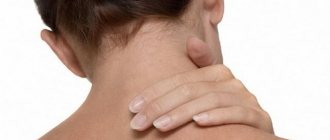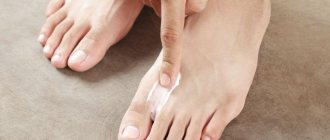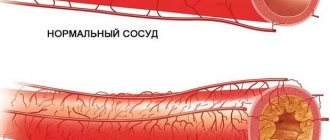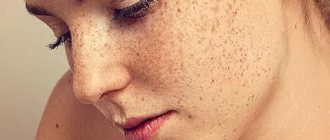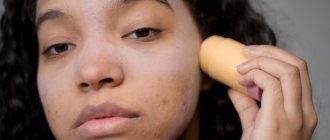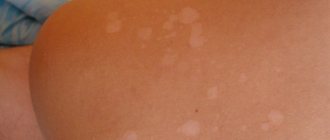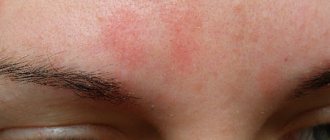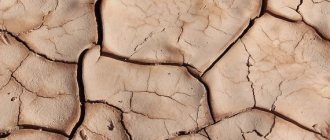A common reason for visiting dermatologists is red spots on the chin, which flake and often cause discomfort to the patient. It is possible that a person is not bothered by unpleasant sensations, but his appearance deteriorates, causing psychological stress and a number of other problems. Therefore, the problem of flaky skin needs to be dealt with, and the sooner treatment is started, the easier and faster it will be to get rid of red spots. What treatment methods exist, and which ones are the most effective?
Why does the skin peel and red spots appear on the chin?
Spots on the chin are a signal from the body about the presence of pathologies or the disturbed course of any process. Before proceeding to neutralize an aesthetic problem, it is necessary to identify the nature of its formation. In this matter, you cannot do without the help of a specialist - a dermatologist, who, in turn, can prescribe a number of additional examinations from an endocrinologist, gastroenterologist, etc.
Attention! The most striking manifestation of allergies is eczema. These are wet or dry spots, the touch of which causes pain. It is better not to touch such stains with your hands, and only professional medical help will help get rid of them.
The most common causes of a rough chin:
- Allergic reactions and irritations (allergens include plant pollen, medications, citrus fruits, household chemicals, etc.);
- Disturbed functioning of the gastrointestinal tract;
- Lack of vitamins and microelements (vitamins A, B, E play an important role in the functioning of the surface layers of the skin);
- Hypovitaminosis;
- Hormonal surge;
- Infectious diseases and immunodeficiencies;
- Deviations in the functioning of the endocrine system;
- Dermatitis, eczema, psoriasis and other dermatological diseases.
However, the reason for the formation of a crust on the chin is not necessarily medical in nature:
- Unsuitable cosmetics and hygiene products;
- Frosty or hot weather;
- Stress and emotional tension;
- Changes in climatic conditions;
- Bad habits;
- Poor nutrition;
- Hereditary factor;
- Failure to comply or improper adherence to personal hygiene rules.
Important! The cause of redness and itching is often a fungus. If it is not eliminated in time, the disease will enter the chronic phase and worsen the quality of life.
So, there are many potential causes of peeling epidermis. Moreover, they are all of a different nature and require mandatory qualified consultation.
Allergies on the face and neck
If it is confirmed that it was allergies on the face and neck that caused the redness and rashes, the allergen will be identified. More often such rashes are provoked by:
- Food;
- Seasonal flowering of plants, pollen;
- Cosmetics for face and neck care;
- Contaminated air;
- Medicines, etc.
Allergy on the chin
If, after diagnosis, the doctor determines that your redness is an allergy on the chin, and not another type of disease, then the allergen will be identified and appropriate therapy will be prescribed. But often a small red rash on the chin indicates hormonal changes in the body. Therefore, such rashes occur:
- In adolescents - during the formation of the hormonal system;
- In adults after 45 years, when restructuring of the body also begins and hormonal levels change.
Then it will be enough to take a blood test for hormones, and the doctor will determine the true cause of the spots on the face.
Allergic acne on forehead
When red spots appear on the forehead, doctors can diagnose:
- Diseases of the small intestine - in the central part of the forehead;
- Adrenal glands - near the eyebrows;
- Rectum - on the left side of the forehead;
- Large intestine - at the top, near the hair;
- Bladder - at the temples;
- Endocrine and hormonal systems - small rash in any area of the forehead;
- The nervous system is a large red spot.
If allergic acne on the forehead is determined after examination, then the treatment regimen is the same:
- Identification of the main allergen;
- Its elimination;
- Prescription of the treatment complex.
You don’t have to wonder why you have a rash on your face, you just need to come to the Allergomed clinic, where they will definitely help you get rid of them.
When should you see a doctor?
In medicine, this phenomenon is called “perioral dermatitis” - redness of the dermis, characterized by localized peeling on the chin and around the mouth. Initially, many small bubbles form, which then begin to itch and peel.
If a red spot appears on your chin, you need to exclude the allergen. Often these are cosmetics containing sodium sulfate, paraffin, petroleum jelly or fragrances. If the stain does not disappear, but, on the contrary, from a single rash has spread to the folds of the mouth and nasolabial triangle, you should immediately consult a doctor.
A dermatologist treats this problem. First, a visual examination is carried out, and then a histological analysis of the skin is prescribed (for this, a scraping is taken from the damaged area of the dermis).
Attention! Peeling skin on the chin is the exfoliation of dead keratinized cells from the top layer - the epidermis. This indicates a disruption in the process of replacing old cells with new ones. The size and appearance of peeling indicate its type: pityriasis, scaly, small- and large-lamellar.
In the photo you can see how isolated red spots initially appeared on the chin. In this case, peeling may have a heterogeneous texture and color (from white to bright red). Also, dryness is sometimes preceded by purulent and watery formations, painless nodes under the skin and local pigmentation. The photo shows that there is a clear boundary between healthy dermis and flaky dermis. Lack of timely treatment leads to the spread of peeling to the forehead, cheeks and nose.
How to eliminate peeling skin?
Red spots on the chin require immediate medical attention. But greater effect can be achieved with an integrated approach to solving this problem. For this purpose, medications, cosmetic procedures and home recipes are used.
Cosmetic procedures
If the cause of redness and peeling on the chin is not a dermatological disease, special procedures will solve the problem. Their goal is to moisturize the epithelium and cleanse dead cells.
- Mesotherapy. The method is based on subcutaneous injections of hyaluronic acid and various meso-cocktails. The procedure will not only relieve the existing syndrome, but also rejuvenate the skin. The technique is good with a minimal list of contraindications and the ability to select any drug.
- Peeling. Chemical cleansing of the face (and body) using fruit and lactic acids. Not suitable for thin and sensitive skin. However, those who are recommended for this procedure can be confident in the quick and painless cleansing of problem areas.
- Biorevitalization. A procedure similar to mesotherapy, which also involves the injection of medications. It is characterized by localized action and the introduction of nucleotides and other biologically active substances.
- Complex techniques for enhanced skin hydration. Facial treatment involves the use of several intensive products at once: tonics, gels, concentrates with active moisturizers (amino acids, enzymes, alginates.
Pharmacy products
When dry skin on the chin is caused by internal causes, medications are prescribed to eliminate the provoking factor. In the fight against dermatitis, regular use of such products is often sufficient. The most effective of them:
- "Lokoid", "Hydrocortisone", "Cortiderm" are corticosteroids used to treat non-infectious diseases. Antibiotic additives of these ointments actively affect the foci of the disease, preventing the development of peeling, and reduce the functioning of the sebaceous glands;
- "Triderm", "Triacutan" - combined ointments based on corticosteroids with the addition of antibacterial additives;
- “Bepanten” - heals cracks and wounds, moisturizes, relieves irritation;
- "Lactofiltrum" - used as an addition to antihistamines. Its main role is to remove toxins;
- "Aquaphor" is a humidifier based on petrolatum. For treatment, you need to cover your chin with a thick layer and do not wash it off. Course of therapy – 14 days;
- "Dexpanthenol" - an anti-inflammatory cream promotes active cell regeneration and accelerates cellular metabolism. Removes red dots on the chin; if there is severe peeling, you can apply it several times a day until a positive effect appears.
Also, pharmaceutical preparations such as zinc ointment, “Losterin”, “Ekolom”, “Gista N”, “Radevit” have proven themselves.
Attention! The body gets used to most anti-allergy medications, which is why their effect weakens. Therefore, after 2 weeks of treatment, it is recommended to change the drug.
We use folk recipes
You can get rid of redness and peeling of the chin at home. Proven folk remedies will help with this:
- Lotions. A cloth or cotton pad is moistened in a strong herbal decoction (with chamomile, string, calendula) and applied to the chin for 15 minutes. You can repeat the procedure up to 5 times a day;
- Compresses. Honey, onion juice and flaxseed oil have proven themselves well. Heat the butter and honey in equal proportions over low heat, add onion juice (1:4). The cloth is moistened and applied to the affected area for 15-20 minutes 3-4 times a day. Other oils are also suitable for this procedure: olive, almond, amaranth, as well as essential oils (lavender, rose, neroli);
- Lotions. Chamomile and green tea have proven themselves as soothing and anti-inflammatory agents. Just pour boiling water over the dried flowers and let it brew for 30 minutes. in a closed container and wipe the flaky and reddened chin;
- Masks. Nourishing mask of 2 yolks, 0.5 tbsp. l. honey and 2 tbsp. l. vegetable oil is slightly heated and warmly applied to the face. After rinsing, apply a nourishing or moisturizing cream. To prepare masks, use cottage cheese, sour cream, and potatoes.
- Scrubs. Ground rolled oats with honey, egg yolk and olive oil are mixed and a homogeneous mass is applied with massage movements, after 10-15 minutes, washed off with warm water. You can remove peeling using salt, soda, and egg-nut scrubs.
If the skin on the chin is peeling and red spots are tormenting you, thermal water, infusion of birch buds, and glycerin masks will help relieve symptoms.
Measures to prevent peeling and redness
“Forewarned is forearmed” - this ironclad rule also applies to skin care. After all, it is easier to prevent unwanted peeling than to deal with the consequences. The main preventive measures are:
- Use of high-quality hypoallergenic cosmetics;
- Proper hygiene;
- Use of sunscreens in direct contact with UV rays;
- Regular examinations and timely treatment of identified diseases;
- The use of gels and aftershave foams;
- Avoiding alcohol-containing cosmetics (instead, it is better to choose products containing oils);
- Remove makeup before bed and heavy physical activity.
If your skin is dry, it needs to be regularly moisturized with special care products.
Attention! If the causes of peeling skin on the chin are caused by allergies, you need to immediately remove the allergen; Pregnancy can also cause excessive dryness of the chin in women.
Allergic rashes on the face
A rash on the face appears in people with a hereditary predisposition to allergies. You may also develop:
- Due to chronic diseases of various types;
- With reduced immunity;
- After undergoing operations;
- If you are often in an environmentally harmful environment or work;
- In contact with animals;
- In the spring - during the flowering of plants;
- With chaotic use of medications and so on.
The main thing that the doctor should do after diagnosis is to determine the main allergen that provokes the rash and eliminate it.
Rashes on the face
If you are allergic to one or another component, a rash can appear on different parts of the body - but more often on the face. It has a different appearance and can be expressed as:
- blisters;
- Dots;
- Nodules;
- Spots.
The appearance of the rash directly depends on the allergen. Based on the appearance and contacts of the patient, the entire rash can be classified into:
- Medicinal - the main provocateur is medication - rash - small spots that gradually occupy an increasing area of the skin;
- Seasonal rhinitis - due to pollen, poplar fluff - red, pronounced spots;
- Allergic dermatitis - most often an occupational type, associated with the environment and contact with stainless metal alloys - in the form of purulent blisters;
- Urticaria - different etiology - red, swollen spots;
- Atopic eczema - has a hereditary nature, in the form of clearly defined spots, often on the skin around the lips and so on.
There are many such varieties, and a doctor will be able to determine the exact allergen and cause of the disease after a thorough diagnosis.
Small rash on the face
Allergic rashes on the face can be on any part of the skin and look like small red dots. A small rash on the face can be not only an allergic reaction, it has different causes:
- Hormonal imbalances;
- Stomach diseases;
- Nervous disorders;
- Improper skin care and so on.
Therefore, it is impossible to independently determine why you have red rashes - laboratory and clinical studies are needed, that is, professional diagnostics. If urticaria is diagnosed (namely, it has a pinpoint arrangement of small spots), then the doctor will prescribe appropriate treatment, taking into account:
- Patient physiology;
- His age;
- Heredity;
- Degree of development of the disease;
- Chronic diseases and so on.
Treatment of minor allergic rashes is a long process that includes a whole range of medical measures.
Rash on the face and neck
Such rashes can also have different causes, ranging from improper hygiene of the neck area to diseases of the internal organs.
It is simply necessary to visit a doctor with such symptoms, because a rash on the face and neck may indicate the onset of serious diseases:
- Corey;
- Rubella;
- Typhus;
- Scarlet fever;
- Meningococcemia.
Rash on the face of an adult
Rashes in adults are more often associated with a number of factors:
- Poor nutrition;
- Bad habits;
- Stress;
- Hormonal changes in the body;
- The onset of serious diseases of internal organs, for example, diabetes;
- The development of a chronic disease of any organ.
Then it’s worth getting examined in a clinic and identifying the disease before it becomes chronic. As you know, all diseases are best treated in the initial stages; later they become incurable and can even lead to death. Therefore, a rash on the face of an adult is a reason to undergo an examination and find out everything about the state of your health.
Recommendations from cosmetologists
To prevent red spots on the chin from bothering you, cosmetologists recommend:
- Do not use antibacterial soap for washing, which causes dryness and tightness of the skin. It is being replaced by a cleansing gel without propylene glycol and sodium lauryl sulfate;
- If the skin itches, cosmetic oil based on flax seeds will help (it will help eliminate red spots on the chin and soften areas that are flaking);
- Apply day cream with oil components daily. When choosing a cream, it is important to consider the time of year and choose a protective agent against low or, conversely, high temperatures. The cream will create a protective film and prevent moisture from evaporating.
Did you know? Ordinary liquid honey, diluted with a small amount of warm water, will soften the face and eliminate flaking. It is enough to massage the skin with your fingertips and wash with clean water.
Photos of red spots and peeling on the chin
In the photographs you can clearly observe the progression of dermatitis from the initial stage to its active phase. This state of affairs indicates untimely treatment or an incorrectly selected treatment program.
Red spots on the chin lead to growth and occupy more areas. In this case, papules and pimples may be observed. Confusing dermatitis, eczema and other diseases with acne, many “intensify” their usual hygiene methods: they often begin to wash their faces with inappropriate products and use all kinds of acne remedies. Often, such measures worsen the situation and threaten consequences in the form of dark spots on the skin or a clear separation of healthy skin from damaged skin.
What to do with acne* on the chin?
Let's start with what you shouldn't do if you have acne - squeeze out blackheads*. Painful subcutaneous pimples* often appear in this part of the face. Their extraction can lead to rupture of the follicle and spread of the inflammatory process into the deeper layers of the skin. To prevent this, you need to properly care for your face and contact a specialist to select a treatment method.
Here's what skin care should be like if acne appears on it:
- use only gentle care products, forget about scrubs for a while;
- do not try to dry your skin with alcohol-containing cosmetics, it does not need it;
- don’t forget about moisturizing, even oily skin needs it;
- be sure to wash off your makeup at night, especially if you used a large amount of it to mask rashes;
- use cosmetics that do not contain comedogenic elements;
- review your diet, exclude potentially dangerous foods (milk, sweets, alcohol, fatty foods, etc.)
If you often experience a chin rash, but the disease is now in remission, you can try to reduce the risk of relapse. To do this, follow these recommendations:
- check the expiration date of your cosmetics and its composition, it may contain comedogenic components;
- change tools for applying cosmetics more often or use products to clean them;
- change bed linen every 1-2 weeks;
- use different towels for hands, body and face;
- get rid of the habit of propping your face with your hand, and generally try not to touch it unless necessary.
These tips do not protect you 100% from acne, but they can reduce the likelihood of acne.
